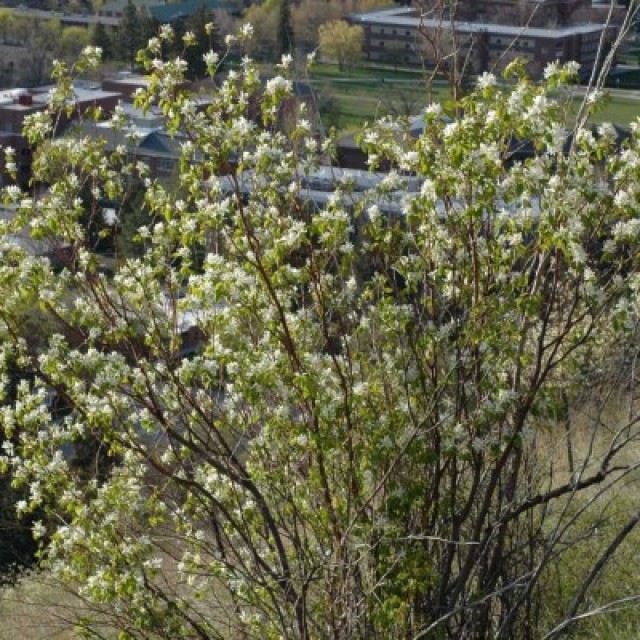COMMON NAME
Western serviceberry
SCIENTIFIC NAME
Amelanchier alnifolia
ALSO KNOWN AS
Juneberry, Saskatoon berry
Plant family
Rose (Rosaceae)
Plant group
Deciduous Trees and Shrubs
Western serviceberry is a deciduous shrub or small tree with roundish leaves. Distinctive teeth are found around at least half of the leaf. The 5-petaled white flowers are found in clusters near the ends of branches.
514 reports
74+
OBSERVERS
514+
OBSERVATIONS
Identification hints
Western serviceberry is a deciduous shrub or small tree with roundish leaves. Distinctive teeth are found around at least half of the leaf. The 5-petaled white flowers are found in clusters near the ends of branches.
Did you know?
Serviceberry is considered a valuable browse species for deer and elk in winter habitat areas. The human uses for this shrub are seemingly endless. It was essential to many Native peoples because not only are the sweet, juicy berries good fresh but they dry very well (like raisins) and save well throughout the winter. They can be dried individually or in cakes.
DISTRIBUTION IN TH U.S.
Alaska
,
California
,
Colorado
,
Iowa
,
Idaho
,
Minnesota
,
Montana
,
North Dakota
,
Nebraska
,
Nevada
,
Oregon
,
South Dakota
,
Utah
,
Washington
,
Wyoming
HABITAT
Often associated with water. Found along hillsides, rocky slopes, stream and roadside banks. Open woods and shrublands, grasslands, and forests at both low and montane elevations.
ATTRIBUTES
Leaves
Alternate leaf arrangement; ovate to round shape, 0.35 to 1.97 in long by 0.31 to 1.77 in wide (9 to 50 mm by 8 to 45 mm). Nearly hairless, generally toothed (serrate) beyond middle of leaf, with a blunt tip. The leaves have distinctive parallel veins coming off at an acute angle from the midrib of the leaf. In the fall the leaves turn a reddish brown before falling off.
Flowers
White to ivory flowers are found in leafy clusters near the ends of the branches. The flower has 5 long white, slender petals that create a star-like shape around a star-like yellowish green center. Flowers bloom in the spring while new leaves are still forming.
Fruits
Western serviceberry fruits are smooth, purple-black and slightly waxy, berries. They are approximately 6-11 mm long.
Bark
The bark is gray-brown to red-brown and the twigs are generally short.
See Menu
- 2021 Chicago Botanic Garden. All Rights Reserved.
-
Creative Commons
BY-NC-SA 4.0 - Terms of Use
- Privacy Policy
- Data Sharing and Citation Policies
- 2021 Chicago Botanic Garden. All Rights Reserved.



